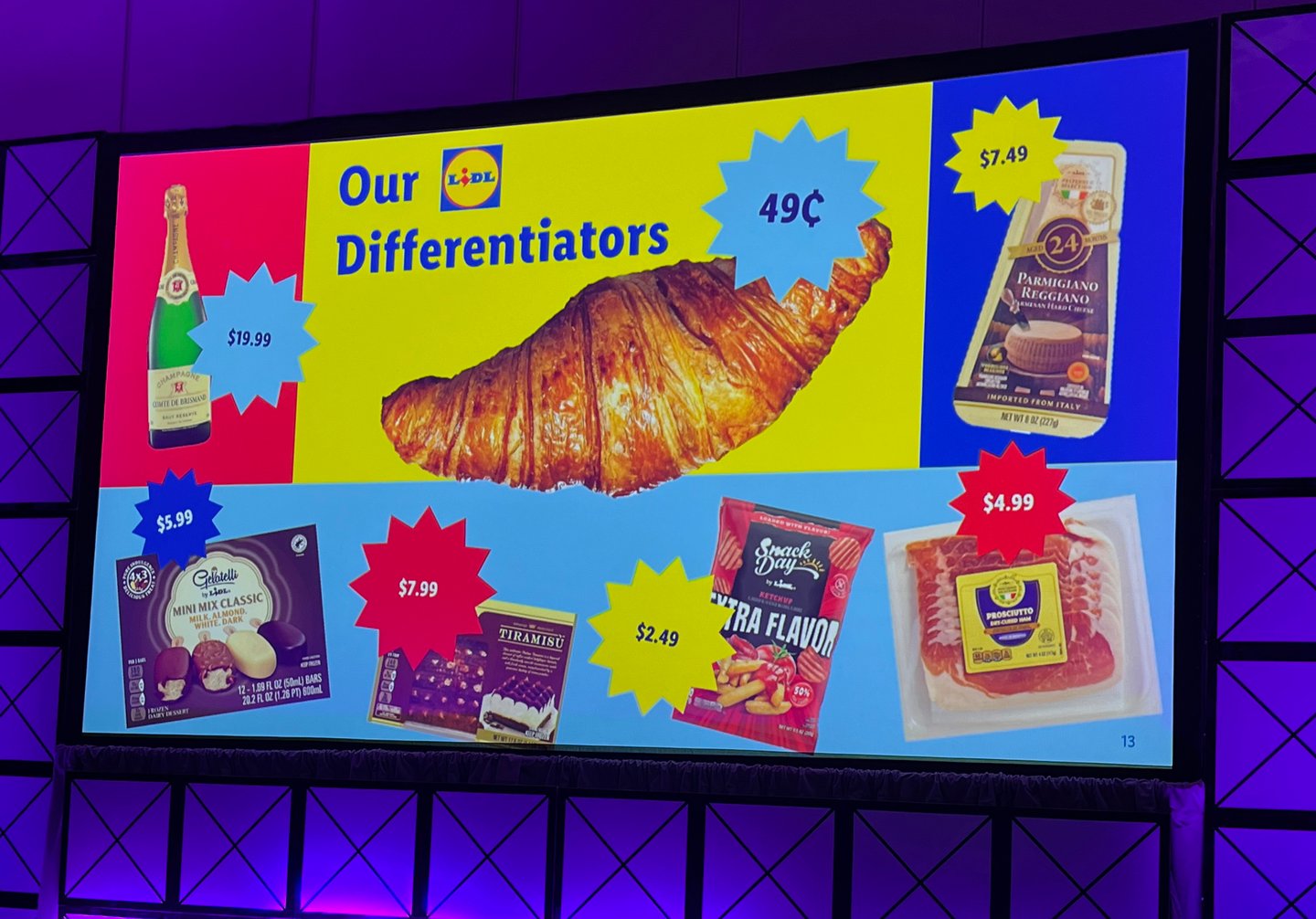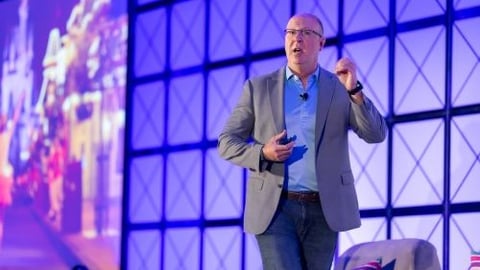EXCLUSIVE: One-on-One With Lidl US CEO Joel Rampoldt
Fresh from his informative presentation at Progressive Grocer’s Grocery Impact event, which took place Nov. 6-8 in Orlando, Fla., Lidl US CEO Joel Rampoldt spent a little extra time with Progressive Grocer answering questions in regard to information shared during his presentation, as well as some insights into how the deep discounter views its competition, what its site-selection process entails, the qualities it looks for in employees, and whether American consumers are confused by the eclectic mix of general merchandise items offered by Lidl. The following interview has been edited for clarity.
Progressive Grocer: First, thank you for the presentation. What would you say is Lidl’s biggest competition in the United States, what types of retailers? What are you actually up against in terms of that might have either a similar value proposition or someplace where people think, “I want to buy inexpensive groceries.” Where would these people go?
Joel Rampoldt: It's a good question. I was actually surprised when I started the job for the first time. I saw the real data on our customer overlaps that we’re sharing customers with, and, of course, the biggest overlap is with the big-box stores and the traditional grocers, which makes sense because they’re everywhere. Just geographically, that was always going to be the case. But when you get below that level, it’s really interesting. We have a lot of overlap with other value-focused but not hard-discount retailers. So, if you think about stores like Costco and Trader Joe’s, just as two examples, we have tremendous overlap with those stores. There’s something about what they offer and what we offer that’s appealing to some of the same customers.
PG: How does that affect where you decide to locate stores? Obviously, you do some kind of studies before you decide where to open stores, but how does whatever the competition is play into that process?
JR: We use a three-step process for thinking about sites. No. 1, which are our strategic markets where we’re going to focus on growing. I talked about that. It’s Atlanta, D.C. and New York. The second step is, where are our customers? Sometimes you can learn a lot about your customers by looking at which competition is there. You assume they’re doing a good job at putting their stores where their customers are. But that’s really the most important part: Where are the customers who are going to what we have to offer? Then the third step is what is the competitive intensity? Who else is there? Who are we going to be taking business away from? Who are we going to be sharing customers with? Really, that is much less important to us. We are very happy to be right up on top of our competition. In fact, we actually like it better, because we opened a store recently that has really strong competition, very, very close by. They draw customers in, and we benefit from that.
PG: You talked about your new brand refresh campaign, and we covered that when it first came out. First, I would ask why was a brand refresh deemed necessary? Why did you decide that you needed a campaign like this?
JR: We needed to relaunch the brand. We had changed so much [from] the last time we did a major brand campaign, [which] was several years ago. When you think about what’s inside the four corners of our stores, particularly fresh fruit and veg, fresh bakery, fresh protein – it’s actually quite different. Our research supported [the idea that] there are a lot of customers out there who had been to our stores but hadn’t been in a long time. We wanted to reintroduce ourselves to the market, to customers who might have tried us and hadn’t been back for a while. Also, because we are a relatively new player, we have a small number of stores compared to our competitors. We have to talk about our brand, we have to talk about who we are, because a lot of people just don’t know.
PG: How did you pick the agency that carried out this vision, and how did you work with them?
JR: We developed the brand strategy first, and we developed the strategy for the campaign first. Then our head of marketing, who is a gentleman named Michael Chao … had a short list of agencies. We met with several very strong agencies, and we felt a very strong connection with MONO from Minneapolis, who’s the agency who’s done all of this for us. We felt like they really understood us and what makes us special, and we felt that the work that they proposed was very well aligned with the brand strategy we had given them. So, it ended up being a pretty easy choice.
PG: I know the campaign has only been out for a relatively short time. Are you seeing any kind of feedback or response from it already? I mean, you talked about the whole idea of it fitting into the frame of a [cellphone] and the social media aspect of it. Are you seeing that across social media?
JR: Yeah, we’re tracking all the things that you would expect – the number of impressions that we’re making, the number of individual customers we’re reaching, the number of impressions per customer – and all of that is going as we expect it to. The performance of the business was strong going into the brand relaunch and has continued, so we’re very happy with what we're seeing so far.
PG: To change tack a little bit, how does Lidl go about recruiting workers? What are the qualities that are looked for in store level associates and up to corporate? Is there a certain ideal Lidl candidate?
JR: There are certain things that we’re looking for, and this is true whether you’re talking about a store team member or someone at HQ. We are looking for people who are interested in providing great service to our customers. Working in our stores is a tough job. It’s very physical. You’re in very cold freezers, and you’re moving heavy product around. You have to really feel like you are getting something out of that because you're providing a necessary service to your community and to the people who come into your store. People who feel that very strongly get a lot out of working for Lidl. Many of them, frankly, could earn similar money doing a job that’s a little bit easier and isn’t as physical and isn’t as tough. But I think that what our store team members do every day – providing the best-price, highest-quality groceries to their community – is something people can get really excited about. So, we work with our store managers and our district managers to try to find people who are going to feel that way.
The counterpoint to that is that at HQ, what we’re looking for is people who understand that they are not important, but the store people are important. You want people who will realize that everything that they’re doing needs to begin and end with what’s happening in the stores. I think everyone with my title in this industry says that, but we really try to live it. It’s all about the stores, and we want to make things harder at HQ so that they can be easier at our 177 stores.
PG: You have a really strong workforce, people who are really dedicated to their jobs, and it’s quite remarkable.
JR: It’s remarkable, and it’s really energizing for me to go out and spend time in stores working with them and just see what they do every day.
PG: You had mentioned your hero products, of course, led by the 49-cent croissant, which everybody raves about. How do you decide on what your hero products are going to be? Do you have a team of people that go out and source these fantastic products?
JR: The way we approached it for this relaunch [is a] tightening of focus on the hero product. We started by saying: “All right, let’s look at what we offer to customers. Which do we think meet the criteria of being a hero product?” It’s got to be something that’s unique. If other people sell it, that doesn’t count. It has to be unique to us. It has to be truly special. And the combination of the highest quality and the lowest price, it has to really go together. Of course, we have lots of products that we love that don’t meet those criteria, so we had several working groups led mostly by the purchasing department, but also by our operations department. We started with a longer list, and we kind of narrowed it down, and it’ll change over time. We’ll rotate it; we’ll focus on different products in different times of the year. But that’s how we started. We started with everyone throwing in their ideas, and that gave us dozens of items. Then we looked at ’em and said: “Is that really unique? Does it meet the bar or not?”
PG: That must be an interesting weeding process.
JR: Everyone has their favorite product, and they’re kind of like a zealot for their product.
PG: Do you retire products?
JR: We may de-emphasize a product. We may talk about a product as a hero product and feature it in our advertising, and then decide actually, we’re going to feature something else. The croissant will always be front and center, though.
PG: Do you have any sneak peeks of either any actual hero products or the types of things you’re looking at?
JR: [Hero products] tend to be focused in the refrigerated and frozen areas. We need more hero products that are center store, and it’s harder to differentiate in the center store.
PG: Over the past few years with all the really strong emphasis on fresh at retail, center store has been kind of left behind a little.
JR: It’s true in the industry, and it's true for us. So the only hint I can drop is I’ve challenged the team and our chief merchant is challenging the team to say, “Okay, we know it’s harder, but how can we really differentiate ourselves in some of these products, these categories which haven’t had as much attention?”
PG: Is there any idea of doing general merchandise products as hero products?
JR: There are a couple of things that we’ve thought about, but our nonfood offering is very seasonal, and we’ve decided a hero product needs to be something that we sell every day.
PG: That makes sense. Have American consumers been confused by your rather robust general merchandise assortment, because it’s not the norm in most American supermarkets, or is it something that they just embrace the minute they come in and see that they can buy snow boots here or lawn furniture or whatever?
JR: I think some customers have been confused by it because, as you say, you don’t expect to see those categories of products in grocery stores. Also, you may find an item that you really, really like, and then if you come back looking for it again a couple of months later, you won’t find it. So, we’re getting the U.S. consumer used to this idea of, it’s constantly refreshing, it’s very seasonally driven, and when it’s gone, it’s gone.
PG: Which, of course, is going to incentivize them to buy it now while they can.
JR: We don’t want them to be disappointed.







